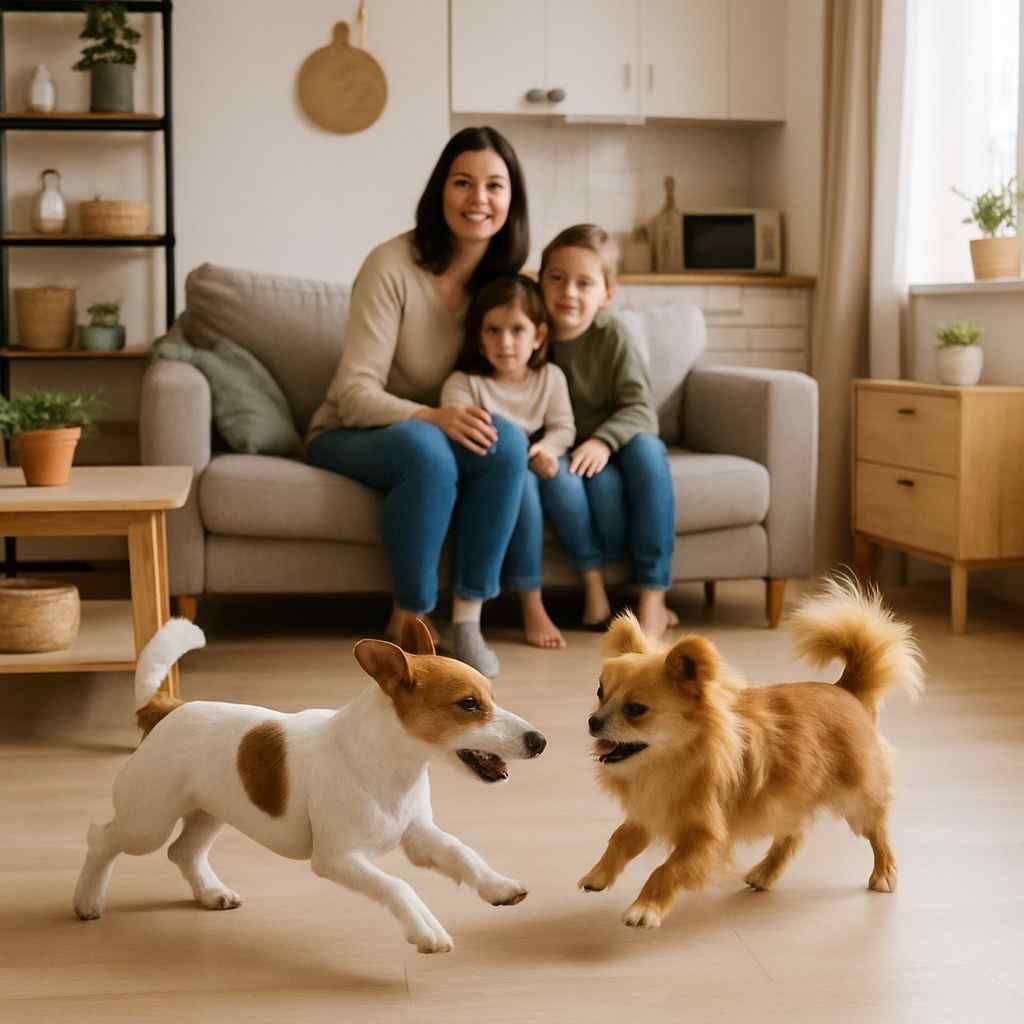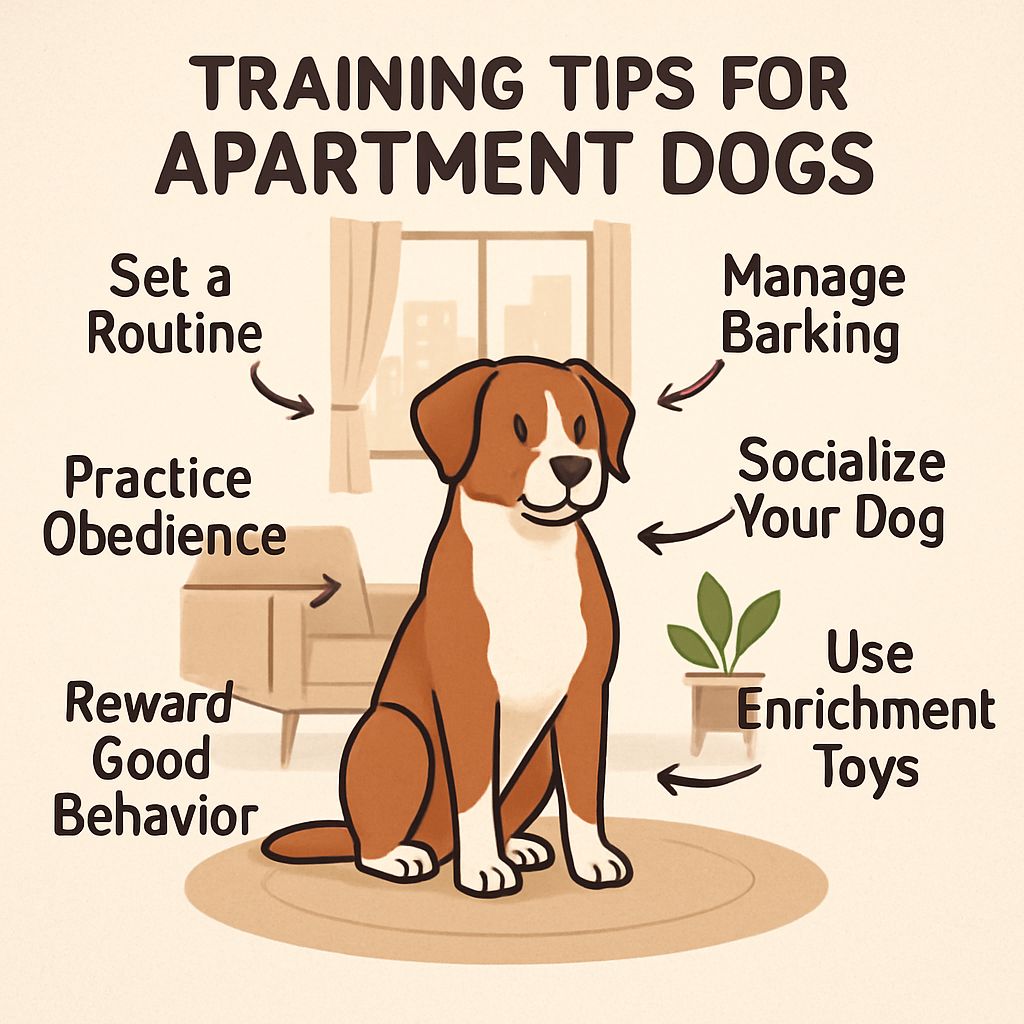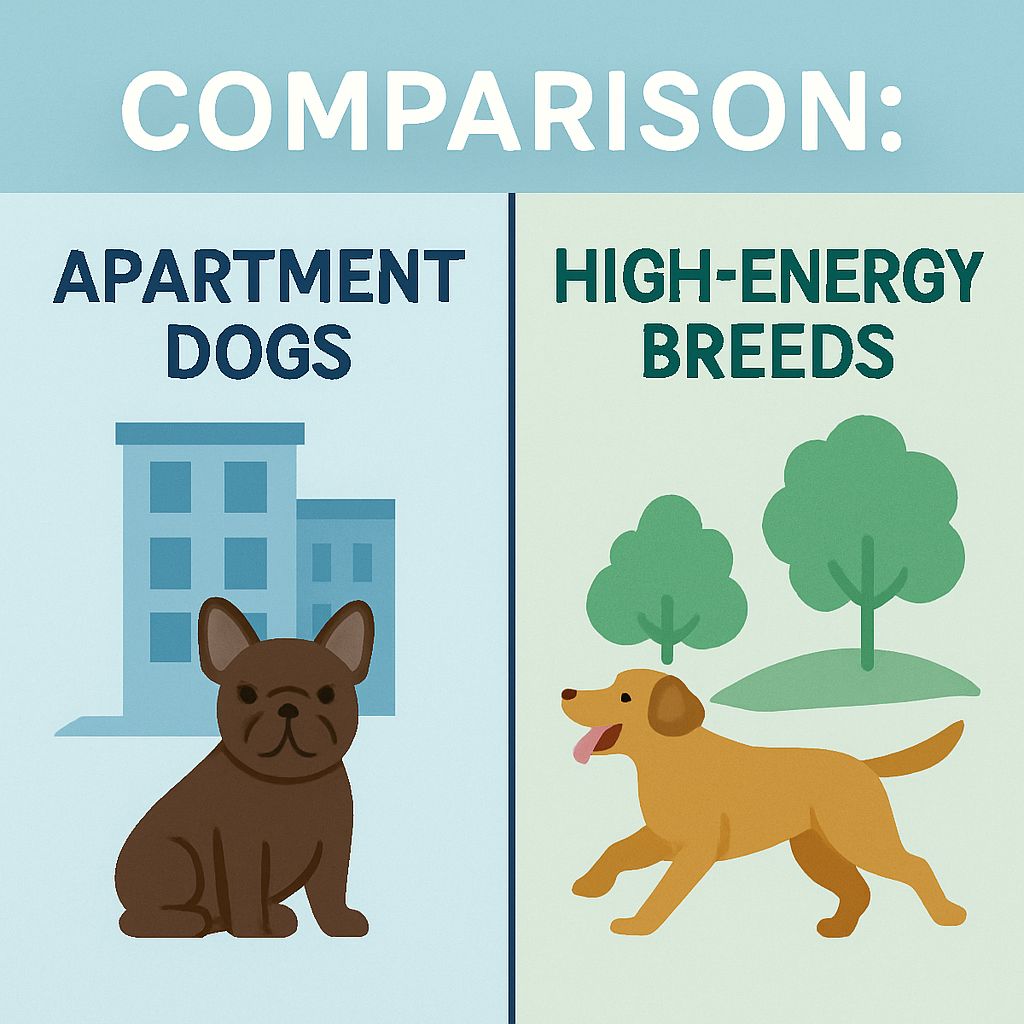“Apartment dogs are the perfect companions for cozy, city living—compact, adaptable, and full of love!”
Table of Contents
Introduction: Why Apartment Dogs Matter

Apartment dogs are getting more attention due to increase urbanization and reduced spaces.These small breeds are best suited for small apartments. Living in an apartment doesn’t mean you have to give up the joy of owning a dog. With urban living on the rise—over 80% of Americans now live in urban areas—more people are seeking canine companions suited to smaller spaces. But not every dog thrives in an apartment.
The right breed, temperament, and training can make all the difference. This guide dives deep into what makes a dog ideal for apartment life, offering practical insights, examples, and tips to help you choose and care for your perfect furry friend. Whether you’re a first-time dog owner or a seasoned pet parent, you’ll find clear, actionable advice to ensure your dog is happy, healthy, and well-suited to your home.
What Makes a Dog Suitable for Apartment Living?
Apartment dogs need specific traits to adapt to small spaces and urban environments. These include size, energy levels, temperament, and adaptability to noise or limited outdoor access. Let’s break it down:
- Size: Smaller dogs (under 30 pounds) are often better suited to apartments due to space constraints. They need less room to move and are easier to manage in tight quarters.
- Energy Levels: Low to moderate-energy breeds are ideal. High-energy dogs may become restless or destructive without enough exercise.
- Temperament: Calm, quiet, and adaptable dogs handle apartment life better. Breeds that are prone to excessive barking or anxiety may struggle.
- Trainability: Dogs that respond well to training can learn to adapt to routines like indoor potty pads or quiet behavior.
Case Study: The Urban Pug
Take Sarah, a graphic designer living in a 600-square-foot apartment in Chicago. She adopted a Pug named Max, a breed known for its small size (14-18 pounds), low exercise needs, and friendly demeanor. Max thrives in Sarah’s apartment because he’s content with short walks and indoor play. His quiet nature keeps noise complaints at bay, and his adaptability suits her busy schedule. This case highlights how choosing a breed with apartment-friendly traits can lead to a harmonious living situation.
Dog Breeds Best Suited for Apartment Living

Choosing the right dog for an apartment involves considering size, energy levels, temperament, and adaptability to smaller spaces. In this article we will discuss some breeds that excel in apartment environments, compiled based on their characteristics, care needs, and suitability for urban living. Each breed’s unique traits make them ideal for cozy homes, ensuring both pet and owner thrive.
| Breed | Size | Energy Level | Grooming Needs | Why Apartment-Friendly |
|---|---|---|---|---|
| Pug | Small (13–20 lbs) | Low | Moderate (sheds) | Low-energy, quiet, adapts well to small spaces. |
| Shih Tzu | Small (9–16 lbs) | Low | High (long coat) | Calm, minimal exercise needs, affectionate. |
| Cavalier King Charles Spaniel | Small (13–18 lbs) | Moderate | Moderate | Gentle, adaptable, happy with short walks. |
| Maltese | Tiny (4–7 lbs) | Low | High (non-shedding) | Quiet, hypoallergenic, thrives indoors. |
| Bichon Frise | Small (12–18 lbs) | Moderate | High (curly coat) | Cheerful, low-shedding, doesn’t need a yard. |
| Havanese | Small (7–13 lbs) | Moderate | High (long coat) | Playful but adaptable, minimal barking. |
| Boston Terrier | Small (12–25 lbs) | Moderate | Low | Quiet, friendly, compact size. |
| Greyhound | Large (50–70 lbs) | Low (!!) | Low | “45-mph couch potato”—sleeps most of the day. |
| Bulldog | Medium (40–50 lbs) | Low | Low | Lazy, minimal exercise, thrives indoors. |
| Chihuahua | Tiny (2–6 lbs) | Low to Moderate | Low | Fits anywhere, minimal space needs. |
| Miniature Schnauzer | Small (11–20 lbs) | Moderate | Moderate (wire coat) | Alert but adaptable, low-shedding. |
| Yorkshire Terrier | Tiny (4–7 lbs) | Moderate | High (long coat) | Portable, minimal exercise needs. |
| Dachshund (Standard/Mini) | Small (11–32 lbs / 8–11 lbs) | Moderate | Low | Compact, burrows into small spaces. |
| Pomeranian | Tiny (3–7 lbs) | Moderate | High (fluffy coat) | Small but alert; needs mental stimulation. |
Special Notes:
- Best for Tiny Apartments: Maltese, Chihuahua, Yorkshire Terrier, Pomeranian (tiny size).
- Best for Low Energy: Greyhound, Bulldog, Pug (surprisingly lazy!).
- Best for Quiet Living: Cavalier King Charles, Havanese, Boston Terrier (minimal barking).
- Best for Hypoallergenic: Maltese, Bichon Frise, Mini Schnauzer (low-shedding).
Notes on Selection for apartment dogs
These breeds were chosen based on their small to medium size (except Greyhound and Bulldog, which are low-energy despite larger size), adaptability to limited space, and calm or trainable temperaments. Exercise needs can often be met with short walks or indoor activities, making them ideal for apartments. Barking tendencies vary, but training can mitigate excessive noise, ensuring harmony with neighbors.
Scientific Insights: How Environment Affects Dog Behavior
Research from the University of Bristol (2019) shows that a dog’s environment significantly impacts its behavior. Dogs in confined spaces with limited stimulation are more prone to stress-related behaviors like chewing or excessive barking. This makes breed selection and training critical for apartment dogs. The study found that breeds with lower energy needs and higher trainability—such as those listed above—exhibit fewer stress behaviors in urban settings. Additionally, providing mental stimulation (puzzle toys, training sessions) can reduce anxiety by up to 40%, according to the Journal of Veterinary Behavior.
Training Tips for Apartment Dogs

Training is key to ensuring your dog thrives in an apartment. Here are practical tips to make it work:
- Housebreaking: Use crate training or pee pads for small dogs. Consistency is crucial—set a schedule for potty breaks (every 4-6 hours for adults).
- Bark Control: Teach the “quiet” command using positive reinforcement. Reward your dog when they stop barking on cue.
- Mental Stimulation: Use puzzle toys, treat-dispensing balls, or short training sessions to keep your dog engaged indoors.
- Exercise Routines: Even low-energy dogs need daily activity. Short walks (15-30 minutes) or indoor games like fetch in a hallway work well.
- Socialization: Expose your dog to urban sounds (elevators, traffic) early to reduce anxiety. Puppy classes can help.
Example: Training a Shih Tzu
Lisa, a New York City resident, adopted a Shih Tzu named Bella. Bella initially barked at every doorbell ring. Lisa used positive reinforcement, rewarding Bella with treats when she stayed calm during noises. She also set up a daily routine of two 20-minute walks and indoor puzzle games. Within three months, Bella’s barking reduced by 80%, and she adapted to apartment life seamlessly.
Creating an Apartment-Friendly Environment
Your apartment can be a haven for your dog with a few tweaks:
- Designate a Dog Zone: Set up a corner with a bed, water bowl, and toys. This gives your dog a safe space.
- Soundproofing: Use rugs or curtains to dampen noise, reducing stress for noise-sensitive dogs.
- Safe Chew Toys: Provide durable toys to prevent destructive chewing. Kong toys filled with peanut butter are a hit.
- Pet-Friendly Furniture: Choose washable fabrics or use throws to protect furniture from shedding.
Common Challenges and Solutions
Apartment living comes with unique challenges for dog owners. Here’s how to tackle them:
| Problem | Impact on Dog | Impact on Owner | Solutions |
|---|---|---|---|
| Limited Space for Movement | Dogs, especially high-energy breeds, may become restless, bored, or develop behavioral issues like chewing or barking due to insufficient room to roam or play. | Owners may struggle with a hyperactive or destructive dog, leading to stress and difficulty maintaining a tidy apartment. | – Regular Outdoor Exercise: Schedule daily walks (at least 30–60 minutes, depending on breed) and trips to dog parks for running and socialization. – Indoor Activities: Use puzzle toys, treat-dispensing toys, or indoor agility setups (e.g., tunnels or low hurdles) to keep the dog active. – Rotate Toys: Keep a small set of toys and rotate them weekly to maintain novelty without cluttering space. |
| Lack of Personal Space | Dogs may feel stressed without a quiet, designated area to retreat, leading to anxiety or irritability. | Owners may feel overwhelmed by constant dog presence, especially in a confined space, impacting relaxation or work. | – Create a Dog Zone: Set up a small, cozy area with a crate, bed, or mat where the dog can relax undisturbed. – Use Vertical Space: Install wall-mounted shelves or a raised pet bed to free up floor space while giving the dog a dedicated spot. – Training Boundaries: Teach commands like “place” to encourage the dog to stay in their designated area when needed. |
| Storage for Pet Supplies | N/A (dogs don’t manage supplies, but clutter can stress them indirectly). | Owners struggle to store food, toys, grooming tools, or leashes in a small space, leading to a cluttered apartment. | – Multi-Use Furniture: Use storage ottomans or benches with compartments to store pet supplies discreetly. – Wall Storage: Install hooks or shelves for leashes, collars, and small items. – Minimalist Approach: Buy supplies in smaller quantities to reduce storage needs and keep only essential items. |
| Noise and Disturbances | Dogs may bark excessively due to boredom, lack of stimulation, or external noises (common in apartments), causing stress. | Owners face complaints from neighbors, potential lease violations, or stress from managing a noisy pet. | – Soundproofing: Use rugs, curtains, or sound-absorbing panels to reduce external noise triggers. – Training: Teach “quiet” commands and reward calm behavior to reduce barking. – Background Noise: Play calming music or white noise to mask outside sounds and soothe the dog. |
| Toilet Training Challenges | Dogs may struggle with inconsistent potty routines due to lack of immediate outdoor access, leading to accidents. | Owners deal with messes, odors, and the hassle of frequent trips outside, especially in high-rise apartments. | – Potty Pads or Indoor Grass: Use washable potty pads or artificial grass patches for emergencies, especially for puppies or senior dogs. – Consistent Schedule: Take the dog out at regular intervals (e.g., morning, afternoon, evening) to establish a routine. – Balcony Solutions: If safe and allowed, create a small potty area on a balcony with artificial turf, ensuring proper drainage and cleaning. |
| Mental Stimulation Deficiency | Lack of space for exploration can lead to boredom, anxiety, or destructive behaviors like chewing furniture. | Owners face increased maintenance costs or stress from managing a bored dog’s behavior. | – Interactive Toys: Provide puzzle feeders, Kong toys, or scent games to engage the dog mentally. – Training Sessions: Short, daily training sessions (5–10 minutes) teaching new tricks to stimulate the dog’s mind. – Socialization Opportunities: Arrange playdates or visits to dog-friendly spaces to provide mental and social enrichment. |
| Furniture and Space Damage | Dogs may chew or scratch furniture due to boredom or lack of space to expend energy, damaging the apartment. | Owners face repair costs, conflicts with landlords, or difficulty maintaining a clean living space. | – Pet-Safe Furniture: Use durable, pet-friendly materials (e.g., leather or tightly woven fabrics) and cover furniture with washable throws. – Chew Toys: Provide a variety of chew toys to redirect chewing behavior. – Exercise Before Alone Time: Ensure the dog is exercised before being left alone to reduce destructive tendencies. |
Comparison: Apartment Dogs vs. High-Energy Breeds

To highlight why certain breeds are better for apartments, here’s a comparison with high-energy breeds:
| Aspect | Apartment Dogs (e.g., Pug) | High-Energy Breeds (e.g., Border Collie) |
|---|---|---|
| Space Needs | Minimal (small living area) | Large (yard or open space) |
| Exercise Requirements | 20-45 min/day | 1-2 hours/day |
| Barking Tendency | Low to Moderate | Moderate to High |
| Suitability for Novices | High | Low (requires experienced owners) |
High-energy breeds like Border Collies or Australian Shepherds need extensive exercise and mental stimulation, which can be tough to provide in an apartment. In contrast, apartment dogs thrive with less space and activity.
Real-Life Insights: What Apartment Dog Owners Say
“Apartment dogs can struggle without proper exercise and stimulation—choose wisely to avoid restlessness.”
I spoke with several apartment-dwelling dog owners to gather real-world insights. Emily, a Seattle resident with a French Bulldog named Coco, shared, “Coco’s low energy is perfect for my studio. We do two short walks daily, and she’s happy to nap while I work from home.” Meanwhile, Tom, who owns a Havanese in Miami, noted, “Training was key. My Havanese learned to stay quiet in the elevator, which kept my neighbors happy.” These stories underscore the importance of breed choice and training.
Conclusion: Finding Your Perfect Apartment Dog
Choosing the right dog for your apartment is about more than just picking a small breed. It’s about matching their energy, temperament, and needs to your lifestyle and space. Breeds like French Bulldogs, Pugs, and Shih Tzus are excellent choices due to their size, low energy, and adaptability. With proper training, a dog-friendly environment, and a commitment to their well-being, your furry friend can thrive in even the smallest urban home. Start by researching breeds, assessing your routine, and preparing your space. Your perfect apartment dog is out there, ready to bring joy to your city life.For information regarding top american breeds please read our article’Top 10 American Breeds”.
Most Frequently Asked Questions
| Frequently Asked Question | Answer |
|---|---|
| What are the best breeds for apartment dogs? | • Low-energy breeds: French Bulldogs, Pugs, or Shih Tzus are ideal apartment dogs due to minimal exercise needs (30–60 min daily). • Quiet temperament: Greyhounds or Cavalier King Charles Spaniels adapt well as apartment dogs with low barking. • Size matters: Smaller apartment dogs fit better, but individual temperament is key. |
| Can high-energy breeds be apartment dogs? | • Challenging but possible: Breeds like Border Collies can be apartment dogs with 1–2 hours of daily intense exercise (e.g., running, dog park). • Mental stimulation: Puzzle toys and training are essential for high-energy apartment dogs. • Owner commitment: Active owners can make apartment dogs of any breed work with effort. |
| How do apartment dogs go potty in small spaces? | • Outdoor walks: Take apartment dogs out 2–4 times daily (every 4–6 hours) to sidewalks or parks. • Indoor solutions: Potty pads or artificial grass mats work for apartment dogs in high-rises or emergencies. • Training: Consistent schedules and rewards ensure apartment dogs avoid accidents. |
| Are apartment dogs happy living in small spaces? | • Happiness depends on care: Apartment dogs thrive with sufficient exercise (30–60 min daily), mental stimulation (toys, training), and routine. • Low-energy breeds: Apartment dogs like French Bulldogs are content with less space. • Avoid boredom: Unstimulated apartment dogs may become anxious or destructive. |
| Is it cruel to leave apartment dogs alone all day? | • Not cruel if needs are met: Apartment dogs can handle 6–8 hours alone with exercise before/after and toys. • Risks: High-energy apartment dogs may get anxious or destructive without activity. • Solutions: Dog walkers or daycare help apartment dogs cope with long absences. |
| How do you manage barking in apartment dogs? | • Training: Teach apartment dogs “quiet” commands to reduce barking at noises (e.g., neighbors). • Stimulation: Exercise and puzzle toys prevent boredom-related barking in apartment dogs. • Soundproofing: Rugs or white noise machines help apartment dogs stay calm. |
| What are the challenges of raising apartment dogs? | • Space constraints: Apartment dogs need designated areas (e.g., crate, bed) to avoid clutter. • Exercise limitations: High-energy apartment dogs require outdoor access for running. • Noise issues: Vocal apartment dogs risk neighbor complaints, needing training to manage. |
| How do you keep an apartment clean with apartment dogs? | • Regular cleaning: Vacuum pet hair and use washable covers for apartment dogs’ furniture. • Storage: Multi-use furniture organizes apartment dogs’ supplies in small spaces. • Hygiene: Clean potty pads or balcony areas daily for apartment dogs to maintain freshness. |
| Can large dogs be apartment dogs? | • Yes, with effort: Large apartment dogs like Greyhounds work if low-energy and exercised (30–45 min daily). • Challenges: High-energy large apartment dogs (e.g., Huskies) need extensive activity and space. • Space management: Raised beds or crates help large apartment dogs fit comfortably. |
| How do you handle apartment dogs with separation anxiety? | • Training: Gradually increase alone time for apartment dogs using crates and calming toys. • Enrichment: Puzzle feeders or music reduce stress in apartment dogs when alone. • Professional help: Trainers can address severe anxiety in apartment dogs to prevent barking or destruction. |

3 thoughts on “The Ultimate Guide to Apartment Dogs: Choosing the Perfect Canine Companion for Small Spaces”